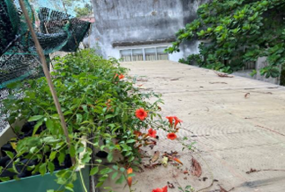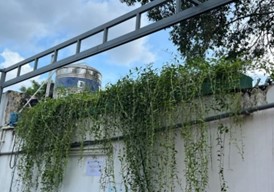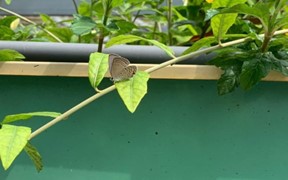Vietnam is a vibrant and rapidly developing nation in Southeast Asia. The country is known for its beautiful coastline and numerous waterways. However, despite its abundant water resources, Vietnam faces serious water-related challenges. Notable among these is urban water pollution, which is driven by a growing population in cities and limited water treatment facilities. Urbanisation is also reducing green areas in cities, thus making them more vulnerable to climate change and related extreme events, such as flooding, drought and urban heat island effects. However, a realisation that nature could be a part of the solution has given rise to several laboratory and pilot studies on using nature-based solutions for water treatment across the country. Furthermore, real-life applications of those technologies are still limited, despite growing evidence of the multiple benefits they generate.
In order to understand some of the barriers and opportunities for the wider application of nature-based solutions for urban water treatment in the country and support their upscaling, an interdisciplinary team of researchers in Vietnam undertook a study of existing practices for nature-based water treatment in cities across the country and identified green roofs and floating wetlands as promising solutions for decentralised wastewater treatment. To explore their potential in the local context, the researchers set up small-scale pilots in Ho Chi Minh City and Can Tho. Based on the results of the trials, they developed step-by-step guidelines for the decentralised establishment and maintenance of floating wetlands and green roofs in Vietnam.
The study was undertaken in the framework of the project “Integrated Assessment of Existing Practices and Development of Pathways for the Effective Integration of Nature-based Water Treatment in Urban Areas in Sri Lanka, The Philippines and Vietnam”, funded by the Asia-Pacific Network for Global Change Research (APN). This article highlights some of the key findings from the research.
Green Roof System Pilot in Ho Chi Minh City
In Ho Chi Minh, the team explores the application of green roof systems for domestic wastewater treatment. Green roofs are “contained” green spaces on top of artificial structures. Green roof systems can be modular, with drainage layers, filter cloth, growing media and plants already prepared in movable interlocking grids. Green roofs provide green spaces in cities, habitats for biodiversity and recreational areas for people. They can also help reduce urban runoff and heat effects and enhance air quality. Furthermore, they can serve as a low-cost urban wastewater treatment system that is easy to design, operate and maintain and enable a circular use of resources with limited energy requirements relative to conventional wastewater treatment systems (Figure 1).
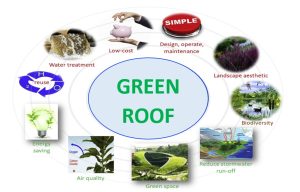
Given those benefits, green roofs are increasingly seen in hotels and other private and commercial buildings across cities in Vietnam. While enhancing green spaces across the city and providing benefits for both people and nature, however, green roofs in Vietnam are usually irrigated with clean water. The main goal of the study was thus to develop and test a set-up that allows green roofs to serve as wastewater treatment wetlands.
In light of the above, a green roof system for wastewater treatment was set up on the roof of a research centre at Ho Chi Minh City University of Technology in Vietnam (Figure 2). The system employs rock, oyster shells, and charcoal as medium layers from bottom to top. Oyster shells were included in the set-up to enable phosphorus removal and charcoal as an adsorbent of organic compounds aimed to improve the treatment performance of the green roof wastewater treatment system. Vernonia elliptica and Trumpet vine were used plants in the trial with a view of their widespread use in green roofs in the country and aesthetic value.
The baseline run of the system showed that Vernonia elliptica and Trumpet Vine can grow well when septic tank effluent is used as the feed water. Furthermore, the physical support in the form of oyster shells and charcoal can be effectively used as filter material and for clogging control. Under a hydraulic loading rate (HLR) of 500 ± 9 m3/ha/day, the removal rates of organic (represented by the chemical oxygen demand, COD), total nitrogen, and total phosphorus were achieved as follows, respectively: 15 ± 7 g COD/m2/day, 0.020 ± 0.006 g N/m2/day, 0.015 ± 0.002 g P/m2/day. The results suggest that the green roof system set up developed in the project can be effectively used for wastewater treatment while providing other benefits, as noted above.
The green roof system set up at Ho Chi Minh City University of Technology employed two modules (each module with two compartments) to compare the two different plants (Figure 3 and Figure 4). The wastewater composition, such as COD, Ammonium nitrogen (NH4+-N) and total phosphorus (TP), was monitored at the inlet and outlet of the system. Wastewater from the influent tank was pumped into the two modules with a flow rate of 54 litres/day (the hydraulic loading rate was 500 m3/ha/day). The wastewater contained 52 ± 14 mg/L of TSS, 335 ± 35 mg/L of COD, 21 ± 12 mg/L of NH4+-N and 2.0 ± 0.8 mg/L of total phosphorus (TP). The treated water from the green roof had 5.0 ± 2.0 mg/L of TSS, 30 ± 13 mg/L of COD, 3.0 ± 0.8 mg/L of NH4+-N and 1.0 ± 0.4 mg/L of total phosphorus (TP), which satisfies the discharge standard limits stipulated by the Ministry of Natural Resources and Environment (QCVN 14:2008). The treated water was thus discharged into the urban sewerage system.
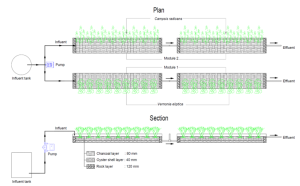
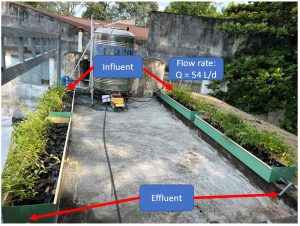
Navigating Implementation and Scaling: Challenges and Opportunities
Installing green roof systems on building rooftops does not currently require government permission. However, future protocols and standards are anticipated to be established as this technology gains wider adoption due to its numerous benefits. Furthermore, while the current dominant set-up of wastewater collection systems in households enables the easy diversion of septic tank effluent for treatment, real-life applications of the system would require the development of cost-effective and easy-to-set-up and manage solutions to pump septic tank effluent to the green roof system. Economically beneficial reuse of the treated water could increase interest in its up-take and scaling. Further barriers and opportunities to replicating and scaling the system will be explored through a household survey.
Constructed Floating Wetlands in Can Tho city
The research team in Can Tho focused on testing the effectiveness of constructed floating wetlands (CFW) as a means of in-situ water treatment in urban canals. In 2019, the Bung Xang Canal in Can Tho City underwent renovation with concrete embankments. However, due to the poor environmental awareness of local residents, the canal suffered from severe water pollution and damage to the surrounding landscapes caused by improper disposal of garbage and wastewater discharge. To address this issue, the research team installed six constructed floating wetlands (CFWs) in the Bung Xang Canal (Figure 5). The results informed the design of the survey study among local residents.
A diverse selection of ornamental plant species, including Canna x generalis, Heliconia psittacorum, Echinodorus cordifolius, Cyperus alternifolius, and Ruellia tuberosa, were incorporated into the CFWs. The findings indicate that Cyperus alternifolius exhibited the best growth and biomass production, followed by Canna x generalis, Heliconia psittacorum, Echinodorus cordifolius, and Ruellia tuberosa, respectively. These plants also contribute to the canal’s aesthetics with their vibrant and colourful flowers, especially when a mix of the five ornamental species is present on each CFW. Additionally, the CFWs have attracted a variety of amphibians, reptiles, fish, birds and other wildlife, including apple golden snails, grasshoppers, frogs, softshell turtles, rats, and bats. The presence of CFWs in the canal has created a healthier environment, enhanced the urban landscape with greenery and promoted biodiversity.
A total of 48 m2 of CFWs (an area of 8 m2 of each CFW) were installed into the 1100 m2 of the Bung Xang Lake section providing 4.4% top surface coverage of the overall area of the canal (https://www.facebook.com/100000212595729/posts/5708455795838117/?d=n). Plants were placed with a density of 9 plants/m2. The CFWs installation was prepared mainly by students of the College of Environment and Natural Resources (CENRes) of Can Tho University. They and the local Youth Union participated in the launch of the CFWs, an event associated with solid waste collection activity. Besides commitments to project implementation support, local authorities and people expressed their special interest in the activities and were excited to see how the CFWs work. They also expected that the CFWs’ water pollution in this canal would be reduced and a more beautiful and green landscape and healthy environment would be created.
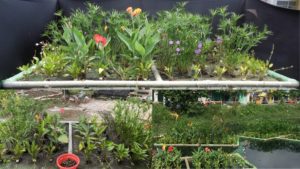
Challenges and opportunities for implementing and scaling
Implementing the constructed floating wetland in the concrete pilot study presented several challenges. These include the presence of untreated urban wastewater, a lack of awareness among local residents resulting in the direct disposal of garbage into the canal, and the need for frequent maintenance of the CFWs due to the accumulation of floating solid waste that can obstruct the treatment systems. Furthermore, the tidal effects in the area, with four tides occurring daily, led to fluctuating water levels, which impacted the assessment of the treatment efficiency. Potential solutions to those challenges and opportunities for future adaptations and scaling were discussed with relevant stakeholders in a focus group discussion.
CENRes organised the focus group discussion. The aim was to discuss the effectiveness and potential replication of the constructed floating wetlands (CFWs) pilot to contribute to making Can Tho a greener, cleaner, more beautiful, and sustainable city while fostering community awareness and enhancing the quality of the urban landscape. The discussion occurred on December 29, 2022, at the Cultural House of Zone 3, An Khanh Ward, Ninh Kieu District, Can Tho City (Figure 6). The meeting gathered 20 participants, including local officers, staff responsible for environmental management in the Bung Xang Canal area, and local residents and students.
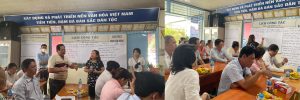
During the discussion, all participants expressed concern with urban water quality and interest in the floating rafts designed and installed by CENRes (Figure 5). They recognised the positive impact of the rafts on enhancing the canal’s aesthetics, improving water quality, and attracting more fish. However, they also recognised that the problem of water pollution in the canal requires a major change in existing practices. A deterioration in the canal’s water quality observed due to improper waste disposal practices suggests the need for a systematic review of the current system’s incentives and support for sustainable resource use and waste management. Meanwhile, the CFW demonstration site has sparked an interest in the technology by other local stakeholders interested in employing it.
Guidelines for supporting the uptake of green roofs and constructed floating wetlands for water treatment
The use of green roof systems for wastewater treatment in Ho Chi Minh City is not yet widespread. These systems are primarily employed to enhance urban green space. To harness the potential of green roofs to serve as wastewater treatment facilities and support the uptake of this approach, guidelines for implementing and maintaining green roofs for wastewater treatment were prepared based on the pilot trial and related research. The guide offers valuable insights into plant selection, pollutant removal mechanisms, and the benefits associated with green roofs. It also provides technical instructions for installation, operation and maintenance procedures to ensure long-term system viability.
As in the case of the green roof system in Ho Chi Minh City, the floating wetland pilot in Can Tho was used to develop a guide that provides detailed information on the materials used in constructing CFWs and the associated costs. The guide also includes step-by-step instructions for designing and installing floating rafts and ensuring proper implementation. Additionally, it presents the results of water quality and plant growth assessments, offering insights into system performance. It also addresses maintenance challenges and provides recommendations and solutions for smooth operation.
Both guidelines are in the process of being tested by external local users as a means of validation. In addition to making them available to local users, the project will include them in an edited volume, thus making them accessible to a wider international public. The book will include instructions on the construction and maintenance of green roofs, floating wetlands and constructed wetlands based on experience from Sri Lanka, the Philippines and Vietnam and is expected to serve as a valuable resource for practitioners and researchers.
